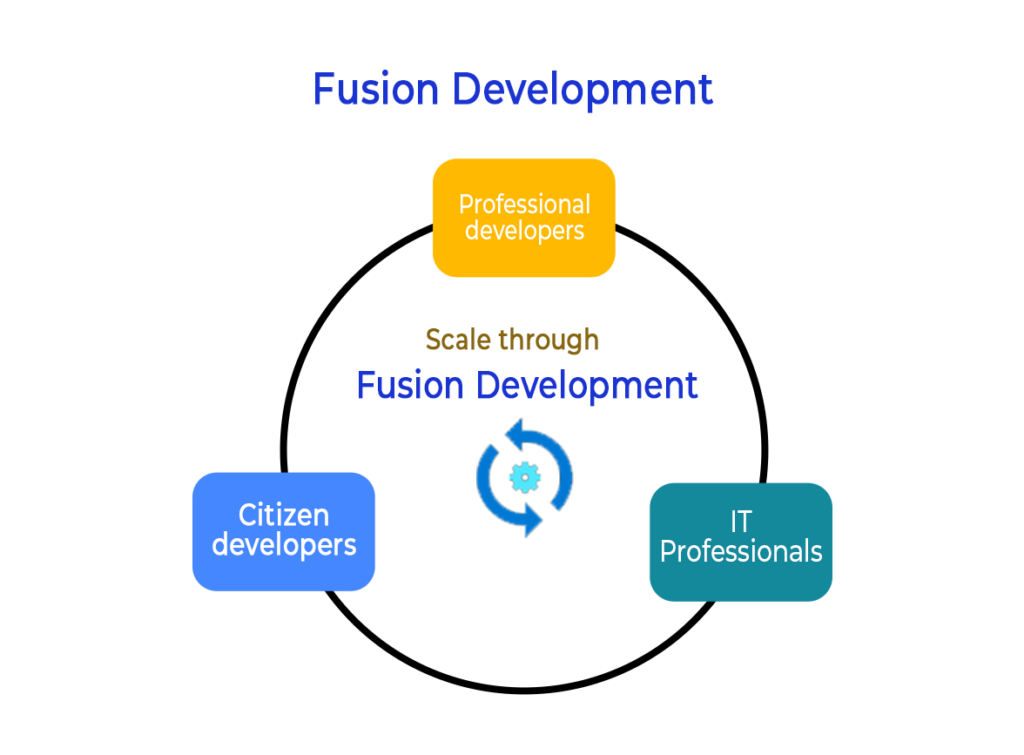Do you know that at least 84% of enterprises have set up fusion teams, most of which use agile methods? In today’s age, where businesses are searching for ways to maximize efficiency and streamline their processes, one solution which is increasingly gaining popularity is fusion development with Power Apps. This approach combines the power of low code and the flexibility of traditional coding. As a result, it enables enterprises to cater to their unique needs with custom solutions agilely. In this blog, we will explore why businesses need to adopt fusion development with Power Apps and how this is revolutionary in today’s evolving business landscape.
The need for speed
The world has changed incredibly over the last few years. The COVID-19 pandemic has forced businesses to shift towards remote work, while workspaces and customer expectations continue to evolve. At the same time, businesses are also facing a struggling economy and supply chain shortage. All these factors have compelled businesses to adopt new operating methods to survive. This being the current reality, it requires businesses to be more resilient and adaptable than ever before. They must be able to respond agilely to changes, which is necessary to maintain employee productivity, streamline processes, and satisfy customers. Most of all, to thrive, regardless of what the future holds.
The journey of digital transformation
Digital transformation is crucial to gaining a competitive edge in this environment. By migrating to the cloud, modernizing business systems and data platforms, automating processes, and enabling mobility, businesses can increase their agility and capability to leverage data and insights. However, to enhance digital experiences and improve efficiency, enterprises know they need to access data, streamline processes, and develop applications even faster. Unfortunately, expensive, and limited IT resources can hinder their progress. The demand for speed has given rise to the democratization of applications, citizen developers, and the phenomenon of low code.
The benefit of Low-Code
Citizen developers arrive when enterprises empower business users to create custom, data-driven apps that support digital transformation. Popular low-code and no-code tools, such as Microsoft Power Platform and Power Apps, fuel this endeavor. They enable non-technical users to develop apps quickly without relying on coding knowledge or IT. These tools have intuitive interfaces, visual editors, and reusable actions for fast development and deployment. Business users are more aware and knowledgeable about their workflows. Hence, they are also best equipped to create the custom solutions required to streamline processes, automate tasks, and access insights needed to improve efficiency and productivity. Thus, citizen developers rise and let their business expertise into app development.
Low-code speeds up automation and maximizes ROI (Return on Investment) and value from their technology investments. This approach takes the burden off IT professionals, reducing their backlog and allowing them to focus on more critical projects.
The demand for Pro-Code
Low code technology does not replace traditional software development. It only adds business users to the team, aka citizen developers, which is cost-effective given the dearth and high cost of skilled professional developers. Yet, the demand for technical and professional development (also known as pro-code) remains. This is because even though low code tools speed up business agility, they have some constraints. However, professional developers are still necessary to handle complex tasks. Such tasks include managing enterprise networks and architecture, modernizing data estates, developing scalable and secure cloud capabilities, and integrating various systems. Additionally, app standardization and governance are crucial to maintaining brand consistency and ensuring the security of company assets.
The best part is that when it comes to low-code and pro-code approaches, you do not have to decide. You can combine both to develop a robust business technology strategy, which is referred to as fusion development.
Bridging the gap with Fusion development with Power Apps
Fusion development with Power Apps is a game-changer in software development. It merges citizen and professional developers into cohesive teams that utilize low-code and traditional development tools and methods. This approach shatters the “glass wall” that separates business and IT by seamlessly integrating technical and analytical skills with business domain expertise. The result is an accelerated digital transformation, with innovative and practical business solutions being built while minimizing risks and failures.
As more enterprises adopt Power Apps and develop apps and automation, the need for fusion development is becoming increasingly prevalent. Enterprises are now seeking to extend and scale their platform, incorporate more advanced visuals, and seamlessly integrate it with their enterprise technology strategy. With Power Apps in fusion teams, these businesses can take their digital transformation to the next level and achieve even greater success.
Advantages of Fusion development
Fusion teams with Power Apps allow low-code and pro-code to coexist peacefully while always utilizing the most effective tools for the task at hand. A business can employ traditional development to have its professional developers create connectors, functions, controls, chatbot capabilities, and many other components. The low-code “makers” can use these components in automation, applications, and chatbots.
The most significant advantages of fusion development with Power Apps are that:
- Businesses have more control over the platform and release cycle.
- Development cycles and Software Development Life Cycle (SDLC) is more enterprise-friendly.
- Low-code makers have more freedom to do more.
- Pro-code and low-code developers are united in a common goal; and
- Solutions have higher adoption rates, lower development costs, and faster time to value.

Benefits of having Fusion teams
Let us have a look at some of the benefits of implementing fusion teams in an organization.
Significant distribution of knowledge sharing
Fusion teams can more effectively share knowledge across the organization by connecting with workers who are traditionally isolated and excluded. Teams that are siloed are unconnected from one another and miss crucial opportunities for knowledge transfer that may strengthen teamwork. This maximized knowledge flow creates a more connected and collaborative team environment.
Rapid digital transformation
Businesses need to keep up with the quick-changing technological landscape. With an agile strategy and a fast-paced approach, Power Apps in fusion teams have been shown to deploy projects and solutions faster. In fact, as per Gartner, it can be two and a half times faster than traditional development. This accelerated pace enables organizations to stay ahead of the curve, innovate quickly, and achieve their digital transformation goals promptly and efficiently.
Higher team autonomy
Fusion teams encourage productive collaboration. They can quickly react and adapt to challenges and opportunities while also developing new tactics that might be more effective. Since fusion teams have higher autonomy, they have more authority to make decisions without the obstacles of bureaucracy (such as numerous stakeholders, lost time, etc.). This increases morale.
Consistent experience across all channels
Building a single multichannel user experience that competes with the competitive marketplace is essential in today’s dynamic digital environment. This is where fusion development and teams come in. As they are consistently testing, and adapting to ensure that users receive everything they need, no matter which channels a user chooses.
Being focussed on your customer’s needs
Business is not just about delivering a great user experience. By focusing on your customer’s needs, fusion teams can help your organization deliver successful products and solutions in less time. Moreover, with real-time feedback and data, fusion teams draw on the skill sets of various internal departments to address customer needs and solve problems swiftly. The success of the organization will ultimately depend on consumer insights and product uptake and fusion teams work to figure out this puzzle inside out.
How can we help?
If you are looking to implement fusion development with Power Apps in your enterprise, look for a partner who can support your digital transformation goals and set you up for success. At Saxon, we provide fusion teams leveraging Power AppsPowerr and professional developers who can tailor your digital solutions according to your business requirements. You can also expand your fusion team, and we can help architect a development effort inclusive of low-code and pro-code. Simply share your use case or challenge, and our experts will provide you with the best solution within a few days.


